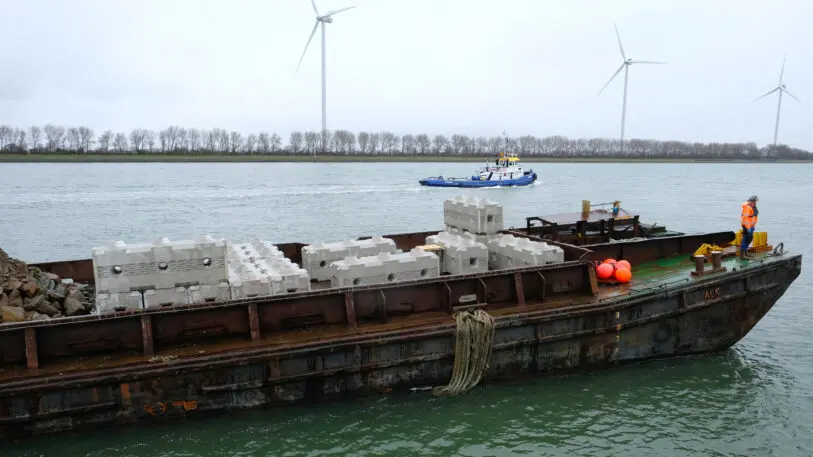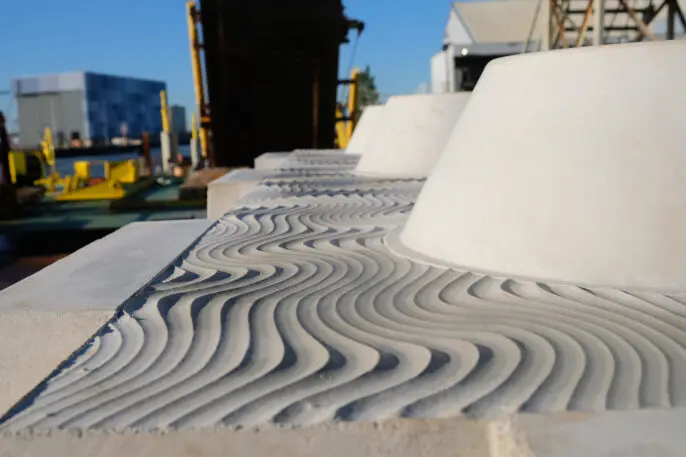The sprawling Port of Rotterdam is one of the largest ports in the world, with hundreds of cargo ships coming and going each day. But for the last decade, the port has been working with partners to help restore nature in the water nearby. The latest test: giant Lego-like blocks installed in a river to help protect the shoreline while doubling as a home for fish, oysters, and mussels.

The blocks, from a Dutch startup called Reefy, can also be used in areas where coral reefs are degraded. “The idea of having these blocks is to provide the foundation for nature to take over—to have a living layer that can grow with sea level rise and self heal in order to attract these key species, which are, in a way, the architects of the underwater world,” says Reefy CEO Jaime Ascencio, who cofounded the company with marine biologist Leon Haines.

Both coral reefs and oyster reefs help naturally protect coastlines; coral reefs can reduce wave energy by 97%, helping shield coastal communities from storm surges and preventing erosion on beaches. As reefs are damaged, some cities have turned to concrete breakwaters for protection, but traditional breakwaters aren’t designed with nature in mind. “They have one purpose, to be cheap and stable against waves,” says Ascencio. “And by not thinking about nature, they miss a lot of things.”
Most breakwater infrastructure isn’t good habitat for marine life. Most artificial reefs, on the other hand, aren’t sturdy enough in strong storms. (Artificial reefs also are often made from trash and can cause other problems: In Florida, one reef made from hundreds of thousands of old tires failed to attract wildlife and then broke apart, damaging natural coral in the area.) Ascencio, originally from Mexico, first started thinking about the challenge as he saw what was happening on beaches near Mexican resorts. Existing artificial reefs, put in place to keep sand from eroding, weren’t strong enough to do the job.
Reefy’s patented design is the first breakwater, the company claims, to both protect the coast and boost marine biodiversity. The huge blocks, made from low-carbon concrete, have a textured surface to attract oysters and mussels. Holes in the blocks let some water flow through since waves hitting a solid wall would bounce back and combine with incoming waves to become even more powerful. The crevasses also provide more habitat for breeding fish and other animals. The company is also testing a “reef paint” it designed with minerals like calcium to attract oysters to the surface of the structure.

The blocks interlock together, and can be arranged in different layouts depending on the site and which marine life are in the area. The startup developed software that considers the pattern of waves and other factors to design the best configuration of blocks. In Rotterdam, 17 blocks form a barrier more than 80 feet long and nearly 10 feet tall.
Some other projects are 3D-printing artificial reefs, a process that can mimic the complex pattern of grooves in organisms like brain coral. Reefy has also experimented with 3D printing—including using materials that naturally biodegrade—but says the blocks are the most economical solution at the moment. “We’re using techniques like casting that can allow us [to] produce locally and [at] a very good price, while still providing the texture and habitat for nature,” says Ascencio. New approaches to making concrete—including low-carbon or carbon-negative concrete that is made locally—can keep the climate impact of manufacturing low.
The startup is beginning to plan projects in other locations, including Mexico. In the Netherlands, as it monitors the new installation in Rotterdam, it’s also beginning to work with offshore wind companies in the North Sea to help build new marine habitat at the base of wind turbines. The water there used to be filled with oyster reefs, Ascencio says, but overfishing decimated them. “We can start the conditions for nature to start developing,” he says, “and then nature will do the job after that.”
Recognize your brand’s excellence by applying to this year’s Brands That Matter Awards before the early-rate deadline, May 3.
